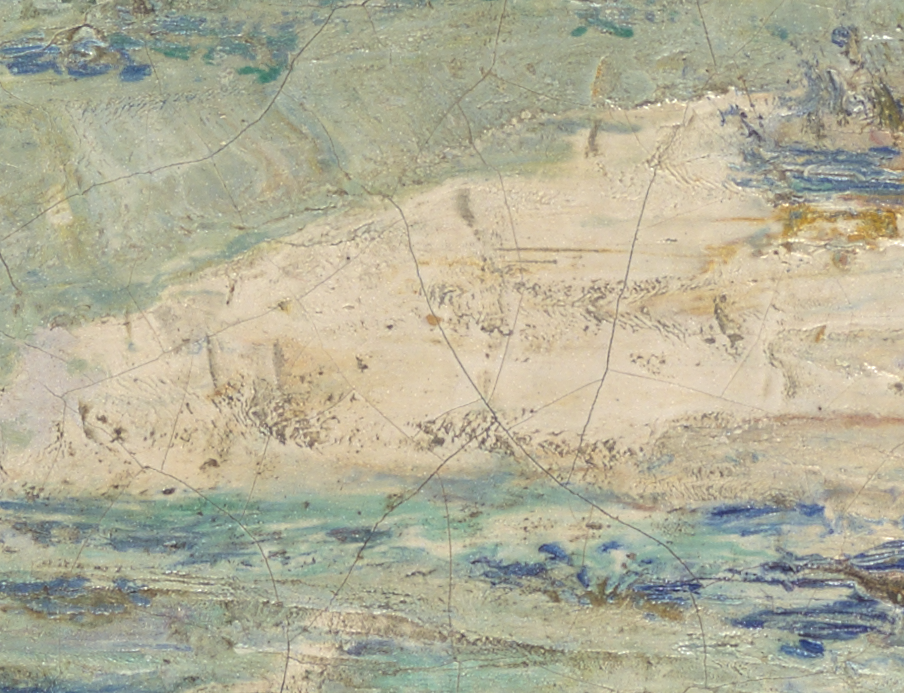I have long wanted to discuss the related disciplines of art conservation and technical art history on this blog but hadn’t found the right angle until now. In part, that’s because I haven’t been able to travel to look at works in person as much as I would have normally, and it can be hard to comment on the materiality of paint using only digital images. Conservation–the technical study and treatment of works of art—and technical art history, which makes use of analytic tools from conservation and other scientific disciplines to shed light on the material histories of art objects, both thrive in the art work’s immediate presence. This week, however, my research has touched directly on both topics. In working on Bend in the River by the American painter Ernest Lawson, I noted a condition report in the object record, part of the curatorial file I am working with. Condition reports are made by conservators and collections management staff to detail any damage or potential issues with the object. In the case of Bend in the River, a conservator noted in 1996 (the year the painting came into the collection) “Watch for structural instability, surface needs to be evened, sky overpainted, very thick, heavy paint has developed craquelure, losses widely scattered….”
This is a pretty standard condition report, indicating that the painting is in overall stable condition, but might need treatment before it can travel on loan to another museum. The term craquelure is one of those great art historical terms, and refers to a network of fine cracks that develop in the surface of a painting, usually as a result of the fact that paint—particularly oil paint—is a slow-drying, organic substance, one which does not behave in an entirely orderly fashion. Thanks to high-quality digital photography, we can examine a portion of the painting close-up and see, sure enough, that it is covered in a fine, spidery web of cracks.

Normally, I might hardly notice such a note. Craquelure is quite common, especially in works by painters who use thicker paints, but also just because of the natural aging process. Another work in the collection, Landscape with Sheep by Albert Pinkham Ryder, shows heavy craquelure, for example. But as I was digging into the research on Lawson, I came across an article written by the art historian Ross Barrett that comments directly on the materiality of Lawson’s painted surfaces. In the essay, which is titled “Speculations in Paint: Ernest Lawson and the Urbanization of New York,” Barrett argues that Lawson’s oeuvre, which is dominated by scenes of the rapidly urbanizing northern frontier of Manhattan, is inextricably bound up in the economic and social process of that urbanization, which involved a great deal of real estate speculation.1 Though it can be hard to imagine a time before Manhattan was covered in dense construction, it is perhaps less surprising that real estate speculation—one of the great New York City pastimes even today—was a part of that process.

Lawson is not known to have kept careful records, and he frequently repeated the same subjects, so it can be difficult to precisely date and locate his works. Nevertheless, we are fairly certain that Bend in the River depicts upper Manhattan, perhaps the Harlem River, in part because nearly all of Lawson’s work from this period of his life (he moved downtown from Washington Heights in 1906) does so.2 Though it may seem to be a bucolic rural scene, it actually thus depicts land on the ragged edge of America’s largest city, land that might even then have been earmarked for the speculative construction of apartment blocks. Barrett notes that Lawson’s contemporaries often considered him a kind of pioneer, one who opened up the urban fringe for painterly consideration in a way that had not been done before.3 That insight alone adds valuably to our understanding of Bend in the River. But Barrett goes further, arguing that Lawson’s very artistic style was bound up in this process of speculation:
The artist employed a method of paint application and a compositional approach that were uniquely suited to the uneven dynamics of speculative development, and he returned to specific spots on the urban border that allowed the richest explorations of these dynamics. Lawson frequently loaded his canvases with thick pigment, heaping up paint with a palette knife in a manner that viewers associated with building and construction.4
And that brings us back to the
conservator’s report with which I began this post. Lawson’s thick impasto, the
way in which he piles up the paint on the surface, has resulted in a painting
that is perhaps more delicate than a smoothly painted work of a similar age. But
in the traces of his palette knife, in the peaks and valleys of this work,
Lawson calls forth the process of building up that would soon overtake this
serene spot on the river. Conservation and technical art history thus allow us
to see this work as both a physical and intellectual act of becoming.
1 Ross Barrett, “Speculations in Paint: Ernest Lawson and the Urbanization of New York,” Winterthur Portfolio 42, no. 1 (March 2008): 1–3.
2 Barrett, 3–4. Even after he moved downtown, Lawson took the elevated trains and subway back uptown to consider his explorations.
3 Barrett, 4.
4 Barrett, 10.

